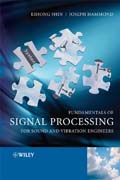
Fundamentals of signal processing for sound and vibration engineers
Shin, Kihong
Hammond, Joseph
Based on the lecture notes given in ISVR, University of Southampton, Fundamentals of Signal Processing for Sound and Vibration Engineers focuses on the fundamental aspects of signal processing. This approach allows readers to easily understand important features, and practice this theory through following the step-by-step explanations of the Matlab examples at the end of each chapter. This concise book is split into two parts covering deterministic signals and random signals, giving clear understanding of their theory and application together with appropriate Matlab examples. INDICE: Preface. 1. Introduction to Signal Processing. 1.1 Descriptions ofPhysical Data (Signals). 1.2 Classification of Data. PART I: DETERMINISTIC SIGNALS. 2. Classification of Deterministic Data. 2.1 Periodic Signals. 2.2 Almost Periodic Signals. 2.3 Transient Signals. 2.4 Brief Summary and Concluding Remarks. 2.5 MATLAB Examples. 3. Fourier Series. 3.1 Periodic Signals and Fourier Series. 3.2 The Delta Function. 3.3 Fourier Series and the Delta Function. 3.4 The Complex Form of the Fourier Series. 3.5 Spectra. 3.6 Some Computational Considerations. 3.7 Brief Summary. 3.8 MATLAB Examples. 4. Fourier Integrals(Fourier Transform) and Continuous-Time Linear Systems. 4.1 The Fourier Integral. 4.2 Energy Spectra. 4.3 Some Examples of Fourier Transforms. 4.4 Properties of Fourier Transforms. 4.5 The Importance of Phase. 4.6 Echoes. 4.7 Continuous-Time Linear Time-Invariant Systems and Convolution. 4.8 Group Delay (Dispersion). 4.9 Minimum and Non-Minimum Phase Systems. 4.10 The Hilbert Transform.4.11 The Effect of Data Truncation (Windowing). 4.12 Brief Summary. 4.13 MATLAB Examples. 5. Time Sampling and Aliasing. 5.1 The Fourier Transform of An Ideal Sampled Signal. 5.2 Aliasing and Anti-Aliasing Filters. 5.3 Analogue-to-Digital Conversion and Dynamic Range. 5.4 Some Other Considerations in Signal Acquisition. 5.5 Shannons Sampling Theorem (Signal Reconstruction). 5.6 Brief Summary. 5.7 MATLAB Examples. 6. The Discrete Fourier Transform. 6.1 Sequences and Linear Filters. 6.2 Frequency Domain Representation of Discrete Systems andSignals. 6.3 The Discrete Fourier Transform. 6.4 Properties of the DFT. 6.5 Convolution of Periodic Sequences. 6.6 The Fast Fourier Transform. 6.7 Brief Summary. 6.8 MATLAB Examples. PART II: INTRODUCTION TO RANDOM PROCESSES. 7. Random Processes. 7.1 Basic Probability Theory. 7.2 Random Variables and Probability Distributions. 7.3 Expectations of Functions of a Random Variable. 7.4 Brief Summary. 7.5 MATLAB Examples. 8. Stochastic Processes; Correlation Functionsand Spectra. 8.1 Probability Distribution Associated with a Stochastic Process. 8.2 Moments of a Stochastic Process. 8.3 Stationarity. 8.4 The Second Moments of a Stochastic Process; Covariance. (Correlation) Functions. 8.5 Ergodicity and Time Averages. 8.6 Examples. 8.7 Spectra. 8.8 Brief Summary. 8.9 MATLAB Examples. 9. Linear System Response to Random Inputs: System Identification. 9.1 Single-Input, Single-Output Systems. 9.2 The Ordinary Coherence Function. 9.3 System Identification. 9.4 Brief Summary. 9.5 MATLAB Examples. 10. Estimation Methods and Statistical Considerations. 10.1 Estimator Errors and Accuracy.10.2 Mean Value and Mean Square Value. 10.3 Correlation and Covariance Functions. 10.4 Power Spectral Density Function. 10.5 Cross-spectral Density Function. 10.6 Coherence Function. 10.7 Frequency Response Function. 10.8 Brief Summary. 10.9 MATLAB Examples. 11. Multiple-Input/Response Systems. 11.1 Description of Multiple-Input, Multiple-Output (MIMO) Systems. 11.2 Residual Random Variables, Partial and Multiple Coherence Functions. 11.3 Principal Component Analysis. Appendices. References. Index.
- ISBN: 978-0-470-51188-6
- Editorial: John Wiley & Sons
- Encuadernacion: Rústica
- Páginas: 368
- Fecha Publicación: 07/03/2008
- Nº Volúmenes: 1
- Idioma: Inglés
